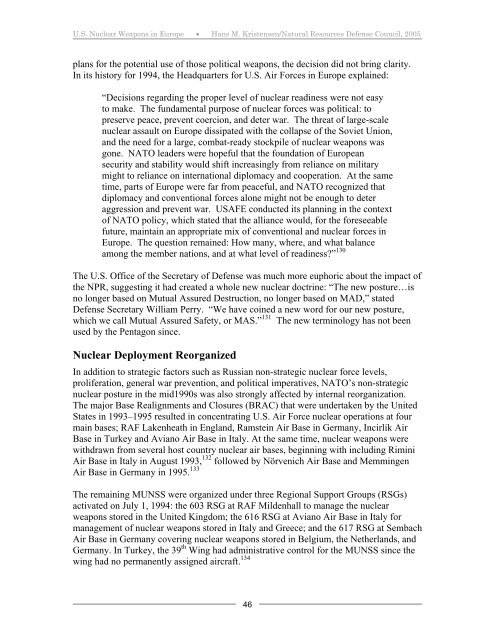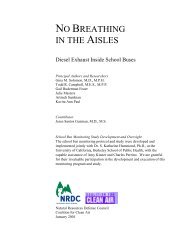US Nuclear Weapons in Europe - Natural Resources Defense Council
US Nuclear Weapons in Europe - Natural Resources Defense Council
US Nuclear Weapons in Europe - Natural Resources Defense Council
Create successful ePaper yourself
Turn your PDF publications into a flip-book with our unique Google optimized e-Paper software.
U.S. <strong>Nuclear</strong> <strong>Weapons</strong> <strong>in</strong> <strong>Europe</strong> • Hans M. Kristensen/<strong>Natural</strong> <strong>Resources</strong> <strong>Defense</strong> <strong>Council</strong>, 2005<br />
plans for the potential use of those political weapons, the decision did not br<strong>in</strong>g clarity.<br />
In its history for 1994, the Headquarters for U.S. Air Forces <strong>in</strong> <strong>Europe</strong> expla<strong>in</strong>ed:<br />
“Decisions regard<strong>in</strong>g the proper level of nuclear read<strong>in</strong>ess were not easy<br />
to make. The fundamental purpose of nuclear forces was political: to<br />
preserve peace, prevent coercion, and deter war. The threat of large-scale<br />
nuclear assault on <strong>Europe</strong> dissipated with the collapse of the Soviet Union,<br />
and the need for a large, combat-ready stockpile of nuclear weapons was<br />
gone. NATO leaders were hopeful that the foundation of <strong>Europe</strong>an<br />
security and stability would shift <strong>in</strong>creas<strong>in</strong>gly from reliance on military<br />
might to reliance on <strong>in</strong>ternational diplomacy and cooperation. At the same<br />
time, parts of <strong>Europe</strong> were far from peaceful, and NATO recognized that<br />
diplomacy and conventional forces alone might not be enough to deter<br />
aggression and prevent war. <strong>US</strong>AFE conducted its plann<strong>in</strong>g <strong>in</strong> the context<br />
of NATO policy, which stated that the alliance would, for the foreseeable<br />
future, ma<strong>in</strong>ta<strong>in</strong> an appropriate mix of conventional and nuclear forces <strong>in</strong><br />
<strong>Europe</strong>. The question rema<strong>in</strong>ed: How many, where, and what balance<br />
among the member nations, and at what level of read<strong>in</strong>ess?” 130<br />
The U.S. Office of the Secretary of <strong>Defense</strong> was much more euphoric about the impact of<br />
the NPR, suggest<strong>in</strong>g it had created a whole new nuclear doctr<strong>in</strong>e: “The new posture…is<br />
no longer based on Mutual Assured Destruction, no longer based on MAD,” stated<br />
<strong>Defense</strong> Secretary William Perry. “We have co<strong>in</strong>ed a new word for our new posture,<br />
which we call Mutual Assured Safety, or MAS.” 131 The new term<strong>in</strong>ology has not been<br />
used by the Pentagon s<strong>in</strong>ce.<br />
<strong>Nuclear</strong> Deployment Reorganized<br />
In addition to strategic factors such as Russian non-strategic nuclear force levels,<br />
proliferation, general war prevention, and political imperatives, NATO’s non-strategic<br />
nuclear posture <strong>in</strong> the mid1990s was also strongly affected by <strong>in</strong>ternal reorganization.<br />
The major Base Realignments and Closures (BRAC) that were undertaken by the United<br />
States <strong>in</strong> 1993–1995 resulted <strong>in</strong> concentrat<strong>in</strong>g U.S. Air Force nuclear operations at four<br />
ma<strong>in</strong> bases; RAF Lakenheath <strong>in</strong> England, Ramste<strong>in</strong> Air Base <strong>in</strong> Germany, Incirlik Air<br />
Base <strong>in</strong> Turkey and Aviano Air Base <strong>in</strong> Italy. At the same time, nuclear weapons were<br />
withdrawn from several host country nuclear air bases, beg<strong>in</strong>n<strong>in</strong>g with <strong>in</strong>clud<strong>in</strong>g Rim<strong>in</strong>i<br />
Air Base <strong>in</strong> Italy <strong>in</strong> August 1993, 132 followed by Nörvenich Air Base and Memm<strong>in</strong>gen<br />
Air Base <strong>in</strong> Germany <strong>in</strong> 1995. 133<br />
The rema<strong>in</strong><strong>in</strong>g MUNSS were organized under three Regional Support Groups (RSGs)<br />
activated on July 1, 1994: the 603 RSG at RAF Mildenhall to manage the nuclear<br />
weapons stored <strong>in</strong> the United K<strong>in</strong>gdom; the 616 RSG at Aviano Air Base <strong>in</strong> Italy for<br />
management of nuclear weapons stored <strong>in</strong> Italy and Greece; and the 617 RSG at Sembach<br />
Air Base <strong>in</strong> Germany cover<strong>in</strong>g nuclear weapons stored <strong>in</strong> Belgium, the Netherlands, and<br />
Germany. In Turkey, the 39 th W<strong>in</strong>g had adm<strong>in</strong>istrative control for the MUNSS s<strong>in</strong>ce the<br />
w<strong>in</strong>g had no permanently assigned aircraft. 134<br />
46
















